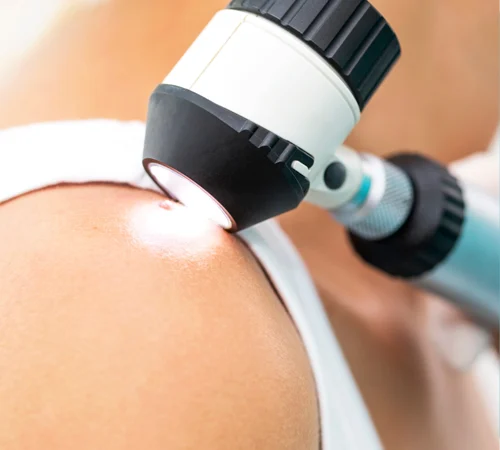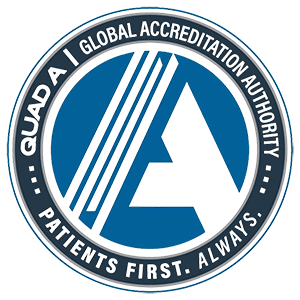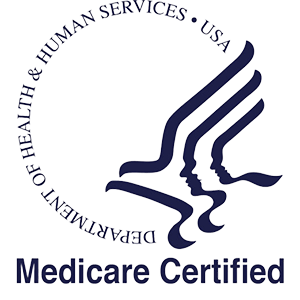Skin Cancer
Skin cancers can be difficult to detect for the average person. Even for experienced dermatologists, it can be difficult to determine whether a lesion is cancerous or not, and a biopsy is required to make a determination.
INTRODUCTION
- Over 5 million skin cancers are diagnosed every year in the U.S. We recommend most patients be seen once a year for routine skin cancer screening because early detection of skin cancer can lead to faster and less invasive treatment.
- Basal cell and squamous cell carcinomas, the two most common forms of skin cancer, are highly treatable if detected early and treated properly. However, the five-year survival rate for melanoma that spreads to distant lymph nodes and other organs is 25%.
- Skin cancer can affect anyone, regardless of skin color. Skin cancer in patients with skin of color is often diagnosed in its later stages, when it’s more difficult to treat.
- At least one in five Americans will develop skin cancer by the age of 70. In the U.S., more than 9,500 people are diagnosed with skin cancer every day. More than two people die of the disease every hour.

We are the Premier Skin Cancer Specialists of Southern California.






Dr. Lin is a board-certified dermatologist and fellow of the American Society for Mohs Surgery with almost 20 years of experience. In 2021, Dr. Lin became one of the first Mohs surgeons to achieve Board certification through the American Board of Dermatology Subspecialty in Micrographic Dermatologic Surgery, the highest level of distinction in dermatologic surgery. He has performed over 10,000 Mohs surgery cases and works with Plastic Surgeons to make sure you have the best cosmetic results possible. We perform the procedure in the clinic and in our AAAASF-accredited and Medicare-certified surgery center. We have the capability to perform the procedure under local anesthesia, conscious sedation, or general anesthesia.
Our Skin Cancer Services
We are dedicated to the diagnosis, prevention, and treatment of skin cancer. Our doctors and associates are experts in their fields and adhere to the highest level of patient care.
An actinic keratosis is a scaly or crusty bump that forms on the skin surface. They are also called solar keratosis, sun spots, or precancerous spots. Dermatologists call them “AK’s” for short. They range in size from as small as a pinhead to over an inch across. They may be light or dark, tan, pink, red, a combination of these, or the same color as ones skin. The scale or crust is horn-like, dry, and rough, and is often recognized easier by touch rather than sight. Occasionally they itch or produce a pricking or tender sensation, especially after being in the sun. They may disappear only to reappear later. Half of the keratosis will go away on their own if one avoid all sun for a few years. One often sees several actinic keratoses show up at the same time. Keratoses are most likely to appear on sun exposed areas: face, ears, bald scalp, neck, backs of hands and forearms, and lips. They may be flat or raised on appearance.
Why is it dangerous?:
Actinic keratosis can be the first step in the development of skin cancer, and, therefore, is a precursor of cancer or a precancer. It is estimated that 10 to 15 percent of active lesions, which are redder and more tender than the rest will take the next step and progress to squamous cell carcinomas. These cancers are usually not life threatening, provided they are detected and treated in the early stages. However, if this is not done, they can bleed, ulcerate, become infected, or grow large and invade the surrounding tissues and, 3% of the time, will metastasize or spread to the internal organs.
The most aggressive form of keratosis, actinic cheilitis, appears on the lips and can evolve into squamous cell carcinoma. When this happens, roughly one-fifth of these carcinomas metastasize. The presence of actinic keratoses indicates that sun damage has occurred and that any kind of skin cancer — not just squamous cell carcinoma can develop. People with actinic keratosis are more likely to develop melanoma also. Sun exposure is the cause of almost all actinic keratoses.
Sun damage to the skin accumulates over time. It is lifetime sun exposure, not recent sun-tanning that adds to your risk. Up to 80% of sun damage is thought to occur before the age of 18. Ultraviolet rays bounce off sand, snow, and other reflective surfaces; about 80% can pass through clouds. The thinning of the ozone layer may be allowing more ultraviolet rays reach the earth. People who have fair skin, blonde or red hair, blue, green, or gray eyes are at the greatest risk. Because their skin has less protective pigment, they are the most susceptible to sunburn. Even those who are darker-skinned can develop keratosis if they heavily expose themselves to the sun without protection.
Individuals who are immunosuppressed as a result of cancer chemotherapy, AIDS, or organ transplantation, are also at higher risk. It seems that while the body is healthy, the lesions are kept in check. When one becomes ill they grow and become malignant more often, although this is not yet proven. Because more than half of an average person’s lifetime sun exposure occurs before the age of 20, keratoses appear even in people in their early twenties who have spent too much time in the sun.
Treatment
There are a number of effective treatments for eradicating actinic keratoses. Not all keratoses need to be removed. The decision on whether and how to treat is based on the nature of the lesion, age, and health.
Cryosurgery, one of the most common treatments done, freezes off lesions through application of liquid nitrogen. This is done with a special spray device or cotton-tipped applicator. It does not require anesthesia and produces no bleeding. The longer the spot is frozen the better the chance it will never come back. Longer freezes can result in hypopigmented areas.
Curettage is another treatment. The physician scrapes the lesion and may take a biopsy specimen to be tested for malignancy. Bleeding is controlled by cautery –application of an acid or heat produced by an electric needle.
Shave Removal utilizes a scalpel to shave the keratosis and obtain a specimen for testing. The base of the lesion is destroyed, and the bleeding is stopped by cauterization.
Chemical peels make use of acids (Jessners solution and/or trichloroacetic acid) applied all over the area. The top layers of the skin peel off and are usually replaced within seven days by growth of new skin. Redness and soreness usually disappear after a few days.
Topical cream is effective in treating keratoses, particularly when lesions are numerous. One of the newest medications (Aldara) works by stimulating the body’s immune system to ‘recognize’ these precancerous lesions and treat them. This is used twice weekly for 6-12 weeks over the affected areas. 5-fluorouracil (Efudex, Carac) cream works by directly attacking the precancerous cells. This is applied once to twice daily for 2 to 4 weeks. Treatment leaves the affected area temporarily reddened and raw and will cause some discomfort resulting from skin breakdown. The more raw and inflamed the skin becomes, the better the end result. Solaraze gel is a non-steroidal medication that also works fairly well on AK’s. Treatment is twice daily for ninety days.
At Unified Health, we are one of the few centers to offer a new treatment called Photodynamic Therapy. This treatment involves applying Levulan® (amniolevulinic acid) to the sun damaged area and activating the medication with a powerful light. The activated medication will cause the sun damaged skin to crust over and fall off leaving new, healthy skin from underneath.
In the United States alone, it’s estimated that about 2 million Americans hear, “You have basal cell carcinoma,” each year.
Most people who develop this skin cancer have fair skin that they seldom protected with sunscreen or sun-protective clothing. Before they developed skin cancer, they often noticed signs of sun damage on their skin, such as age spots, patches of discolored skin, and deep wrinkles.
You have a greater risk of developing this skin cancer if you’ve seldom protected your skin from the sun throughout your life or used tanning beds.
Although BCC is most common in people who have fair skin, people of all colors get this skin cancer.
For most people, BCC is not life-threatening. It tends to grow slowly. It seldom spreads to another part of the body. Even so, treatment is important.
When found early, this skin cancer is highly treatable. An early BCC can often be removed during an appointment with your dermatologist.
Given time to grow, this skin cancer can grow deep, injuring nerves, blood vessels, and anything else in its path. As the cancer cells pile up and form a large tumor, the cancer can reach into the bone beneath. This can change the way you look, and for some people the change may be disfiguring.
Finding and treating this skin cancer early can prevent it from growing deep. To do this, it helps to know the signs and symptoms of BCC.
One common sign is a slowly growing, non-healing spot that sometimes bleeds. BCC can also appear on the skin in other ways.
What are the signs and symptoms of basal cell carcinoma?
Basal cell carcinoma is a type of skin cancer that can show up on the skin in many ways. Also known as BCC, this skin cancer tends to grow slowly and can be mistaken for a harmless pimple, scar, or sore.
To help you spot BCC before it grows deep into your skin, dermatologists share these 7 warning signs that could be easily missed.
If you find any of the following signs on your skin, schedule an appointment with Dr. Michael Lin.
7 warning signs of basal cell carcinoma that you could mistake as harmless
- Warning sign: A pink or reddish growth that dips in the center
Can be mistaken for: A skin injury or acne scar - Warning sign: A growth or scaly patch of skin on or near the ear
Can be mistaken for: Scaly, dry skin, minor injury, or scar - Warning sign: A sore that doesn’t heal (or heals and returns) and may bleed, ooze, or crust over
Can be mistaken for: Sore or pimple - Warning sign: A scaly, slightly raised patch of irritated skin, which could be red, pink, or another color
Can be mistaken for: Dry, irritated skin, especially if it’s red or pink - Warning sign: A round growth that may be pink, red, brown, black, tan, or the same color as your skin
Can be mistaken for: A mole, wart, or other harmless growth. - Warning sign: A spot on the skin that feels a bit scaly
Could be mistaken for: Age spot or freckle. - Warning sign: A scar-like mark on your skin that may be white, yellow, or skin-colored and waxy. The affected skin may look shiny and the surrounding skin often feels tight.
Could be mistaken for: A scar
Where does BCC develop?
As the above pictures show, this skin cancer tends to develop on skin that has had lots of sun exposure, such as the face or ears. It’s also common on the bald scalp and hands. Other common areas for BCC include, the shoulders, back, arms, and legs.
While rare, BCC can also form on parts of the body that get little or no sun exposure, such as the genitals.
What color is BCC?
This skin cancer tends to be one color, but the color can vary from one BCC to the next. This cancer may be:
- Red or pink (most common)
- Brown, black, or show flecks of these colors
- The same color as your skin
- Yellowish
- White
Does BCC hurt?
For many people, the only sign of this skin cancer is a slow-growing bump, sore-like growth, or rough-feeling patch on their skin. However, some people develop symptoms where they have this skin cancer.
Symptoms include:
- Numbness
- A pins-and-needles sensation
- Extreme sensitivity
- Itching
How do people find BCC on their skin?
Many people find it when they notice a spot, lump, or scaly patch on their skin that is growing or feels different from the rest of their skin. If you notice any spot on your skin that is growing, bleeding, or changing in any way, see a board-certified dermatologist. These doctors have the most training and experience in diagnosing skin cancer.
To find skin cancer early, dermatologists recommend that everyone check their own skin with a skin self-exam. This is especially important for people who have a higher risk of developing BCC.
The Squamous Cell Carcinoma (SCC) can be found on any skin surface or mucous membrane. It is the second most common skin cancer. The aggressiveness of this skin cancer is highly variable. In general, the larger the SCC, the more likely the SCC will invade deeper structure, nerves, lymphatics, blood vessel, and spread to other parts of the body. Early diagnosis and treatment is important in reducing morbidity and mortality.
Most commonly, the SCC is found on sun-damaged skin, either as a new red scaly bump or evolving from a flat scaly patch known as an actinic keratosis. Typically, these lesions grow over the course of many months to years. However, in a special variant of SCC called the keratoacanthoma, the lesion may grow to a tremendous size in a short amount of time.
The SCC is usually biopsied by the dermatologist to obtain a diagnosis. If a diagnosis of squamous cell carcinona is confirmed, the treatment options are discussed. Depending on the location, size, and needs of the patient, the appropriate treatment is determined.
The following are the treatment options for SCC:
Topical treatments- Imiquimod (Aldara, Zyclara), ingenol mebutate (Picato), 5-fluorouracil (Efudex, Carac) (Time: 4-16 weeks, Cure rate: 50-90%)
Electrodessication and Currettage- Scraping and burning of the lesion. No pathology confirmation of removal. (Time: 15 minutes, Cure rate: 85-90%)
Excision- Cutting out the skin cancer with a scalpel. Surgical margins examined for clearance of tumor. Re-excision may be necessary if margins are not clear. (Time: 60-90 minutes, Cure rate: 85-90%)
Mohs Surgery- Cutting out the skin cancer under microscopic control. After removal of the skin cancer with small margins, the tissue is mapped out and cut in a way to be able to examine the deep and side margins. If the margins are clear, the wound can be closed. If the margins are not clear, a small amount of additional tissue is removed in only the involved area. This tissue is then inspected microscopically and if the margins are now clear, the wound can be closed. If not clear, the process is repeated until the margins are finally clear and the wound is finally closed. (Time: 2 hours- 8 hours, Cure rate: 90-99%)
Radiation and Electronic Brachytherapy- Lesion is exposed to radiation in multiple doses. Eight to twenty sessions may be needed. (Time: 15 minute appointment per session over 1 month period, Cure rate:85-90%)
Skin cancer can be divided into non-melanoma and melanoma types. Non-melanoma (basal cell and squamous cell skin cancer) is the more common form with over 3,000,000 cases diagnosed annually in the US. Most of these forms of cancer are curable. Melanoma, on the other hand, is a more serious skin cancer type. Although it affects approximately 5 percent of skin cancer cases, it causes over 75 percent of all skin cancer deaths. An estimated 76,690 new cases of invasive melanoma will be diagnosed in the US in 2013 and an estimated 9,480 people will die of melanoma in 2013.
Know How to Spot Melanoma with the ABCDE’s
Melanoma usually presents as a pigmented (dark) mark on the skin. You can perform your own skin cancer self-exam with the signs that dermatologists look for, called the ABCDEs.
A) Asymmetry-One half unlike the other half.
B) Borders- Irregular, scalloped or poorly defined border.
C) Color- Varied from one area to another; shades of tan and brown, black; sometimes white, red or blue.
D) Diameter- While melanomas are usually greater than 6mm (the size of a pencil eraser) when diagnosed, they can be smaller.
E) Evolving- A mole or skin lesion that looks different from the rest or is changing in size, shape or color.
To diagnosis a melanoma, a dermatologist may perform either a shave biopsy, punch biopsy, or excisional biopsy. The type of biopsy depends on many factors, depending on the size, shape, location, and other factors.
If a diagnosis of melanoma is confirmed, the treatment protocol varies widely depending on many factors, including size, depth, ulceration, lymph node involvement, genetic testing, and mitotic index (cancer cell activity).
Treatment may include:
Excision- Cutting out the skin cancer with a scalpel. Surgical margins examined for clearance of tumor. Re-excision may be necessary if margins are not clear. (Time: 60-90 minutes)
Mohs Surgery- Cutting out the skin cancer under microscopic control. After removal of the skin cancer with small margins, the tissue is mapped out and cut in a way to be able to examine the deep and side margins. If the margins are clear, the wound can be closed. If the margins are not clear, a small amount of additional tissue is removed in only the involved area. This tissue is then inspected microscopically and if the margins are now clear, the wound can be closed. If not clear, the process is repeated until the margins are finally clear and the wound is finally closed. (Time: 2 hours- weeks, if specimens need to be processed in formalin instead of by frozen section)
Excision with sentinel node biopsy- Cutting out the skin cancer with a scalpel. Dye is injected at time of excision in the location of the excision, and the lymph nodes where the dye drains to are removed and examined of melanoma cells. Surgical margins examined for clearance of tumor. Re-excision may be necessary if margins are not clear. (Time: 60-180 minutes).
Chemotherapy- These medications attack the melanoma cells to kill them in the body. The drugs are usually injected into a vein or taken by mouth as a pill. They travel through the bloodstream to all parts of the body and attack cancer cells that have already spread beyond the skin. Because the drugs reach all areas of the body, this is called a systemic therapy.
Several chemotherapy drugs can be used to treat melanoma:
Dacarbazine (also called DTIC)
Temozolomide
Nab-paclitaxel
Paclitaxel
Carmustine (also known as BCNU)
Cisplatin
Carboplatin
Vinblastine
Immunotherapy- Immunotherapy is the use of medicines to stimulate a patient’s own immune system to recognize and destroy cancer cells more effectively. Several immunotherapy medications can be used to treat patients with advanced melanoma, either alone or in combination with chemotherapy medications.
Ipilimumab (Yervoy)
interferon-alpha
interleukin-2
Bacille Calmette-Guerin (BCG) vaccine
Imiquimod (Aldara, Zyclara)
Clinical Trial Medications- fortunately, research into melanoma treatments is very active. Many new treatments are being developed and clinical trials are available. Please visit Information on Clinical Trials 1 or Information on Clinical Trials 2 for more details.
Cryotherapy is the use of liquid nitrogen to destroy skin cancer cells by freezing the cells to extremely low temperatures. This freezing disrupts the superficial layers of the skin and causes these skin cells to separate and fall off. Careful placement of the liquid nitrogen specifically on the skin cancer cells is important to avoid damaging surrounding tissue. This technique is very useful on superficial skin cancers and pre-cancers. Deeper tumors may not respond to cryotherapy due to the inability of the cold to penetrate too deeply without damaging surrounding tissue.
Electrodessication and curettage (scraping and burning) is a technique in which a sharp instrument is used to scrape off the skin cancer and then a small electric needle is used to burn the base. The procedure is extremely quick to perform and no stitches are needed. Cure rates are typically 85-90%, depending on the location. The scraping and burning leaves a round scar slightly larger than the original skin cancer. It starts our pink but eventually fades to a lighter skin color.
Biopsies are extremely important and are performed for the diagnosis and treatment of skin cancers. Biopsies allow us to determine first if a lesion is cancerous or not. Second, they allow us to determine which treatment options are the most appropriate for that specific skin cancer. Not all skin cancers are the same. Even within the category of a specific skin cancer, such as squamous cell carcinoma, there are many subtypes that respond differently to different treatment options.
There are two types of biopsies routinely performed at the dermatologist office, the shave biopsy and the punch biopsy.
Shave Biopsy
The shave biopsy involves taking a thin, superficial layer of skin using a broad, flat blade. For most skin cancers only a small portion of the cancer is removed, however, in pigmented growths, often the entire growth will be removed.
Punch Biopsy
The punch biopsy involves using a special circular instrument to remove a core sample of a growth. These biopsies are typically deeper and more useful for deeper lesions in which the depth of a growth is important to be determined. It is also useful for larger growths in which multiple punch biopsies are obtained to get multiple samples of different areas of the growth.
Actinic keratoses (AKs) are rough-textured, dry, scaly patches on the skin including the face or scalp that can lead to skin cancer. It is important to treat AKs because there is no way to tell when or which lesions will progress to squamous cell carcinoma (SCC), the second most common form of skin cancer. So, now’s the time to manage your damage!
How does it work?
Levulan Photodynamic Therapy, a 2-part treatment, is unique because it uses a light activated drug therapy to destroy AKs.
Levulan Kerastick Topical Solution is applied to the AK. The solution is then absorbed by the AK cells where it is converted to a chemical that makes the cells extremely sensitive to light. When the AK cells are exposed to the BLU-U Blue Light Illuminator, a reaction occurs which destroys the AK cells.
The 2-part treatment offers the following conveniences:
- No prescription to fill
- No daily medication to remember
- Treatment is administered by a qualified healthcare professional
Levulan PDT can also fit your lifestyle:
- The 2-part, 2 office visit treatment is completed in less than 24 hours
- Low downtime*
- High ratings for cosmetic response (1)
- No scarring reported to date
*Patients treated with Levulan PDT should avoid exposure of the photosensitized lesions to sunlight or prolonged or intense light for at least 40 hours.
Ask your dermatologist if Levulan PDT is right for you!
(1) Data on file; DUSA Pharmaceuticals, Inc.®
Important Risk Information
What is Levulan Kerastick used for?
The Levulan Kerastick for Topical Solution plus blue light illumination using the BLU-U Blue Light Photodynamic Therapy Illuminator is indicated for the treatment of minimally to moderately thick actinic keratoses of the face or scalp.
Who should NOT take Levulan?
Levulan Kerastick should not be taken by patients who have cutaneous photosensitivity at wavelengths at 400-450 nm, porphyria, or known allergies to porphyrins, and in patients with known sensitivity to any of the components of the Levulan Kerastick for Topical Solution.
Levulan Kerastick has not been tested on patients with inherited or acquired coagulation defects. There have been no formal studies of the interaction of Levulan Kerastick for Topical Solution with any other drugs and no drug-specific interactions were noted during any of the controlled clinical trials. It is possible that concomitant use of other known photosensitizing agents might increase the photosensitivity reaction of actinic keratoses treated with the Levulan Kerastick. It is important to tell your physician if you are taking any oral medications or using any topical prescription or non-prescription products on your face or scalp. Tell your doctor if you are pregnant or nursing.
What are the possible side effects?
The most common side effects include scaling/crusting, hypo/hyper-pigmentation, itching, stinging, and/or burning, erythema and edema. Severe stinging and/or burning at one or more lesions being treated was reported by at least 50% of patients at some time during the treatment.
What precautions should be taken?
Patients should avoid exposure of the photosensitive treatment sites to sunlight or bright indoor light for at least 40 hours after application of Levulan Kerastick. Exposure may result in a stinging and/or burning sensation and may cause erythema or edema of the lesions. Sunscreens will not protect against photosensitivity reactions caused by visible light.
You are encouraged to report negative side effects of prescription drugs to the FDA. Visit www.fda.gov/medwatch, or call 1-800-FDA-1088.
Topical chemotherapy involves the use of creams to treat skin precancers or cancers. These medications include medications like 5-fluorouracil, imiquimod, picato, and solaraze. In general, these medications are effective in treating precancers or superficial skin cancers, but do not penetrate deep enough to treat invasive skin cancers.
Excision of a skin cancer requires the removal of healthy skin tissue around it (this is called a margin). For this procedure, the surgeon use a local anesthetic, such as lidocaine to numb the skin. The skin cancer is excised with a scalpel and sutures are placed to close the wound. If the incision is large or deep, multiple layers of suture are needed. Deep sutures are typically the dissolving type and slowly dissolve over several months. Superficial sutures are placed to closely line up the skin edge for a better cosmetic result. These sutures are removed in one to two weeks. Sometimes a skin graft or flap is required to move skin from one part of the body to another.
Used to treat skin cancer, this surgery has a unique benefit. During surgery, the surgeon can see where the cancer stops. This isn’t possible with other types of treatment for skin cancer.
The ability to see where the cancer stops gives Mohs (pronounced Moes) two important advantages:
- Mohs has a high cure rate.
- Mohs allows you to keep as much healthy skin as possible because the surgeon only removes the skin with cancer cells. This is especially important when skin cancer develops in an area with little tissue beneath (e.g., eyelid, ear, or hand).
What is it like to have Mohs surgery?
If you have Mohs surgery, you’ll see a doctor who is a trained Mohs surgeon. Most Mohs surgeons are dermatologists who have completed extensive training in Mohs surgery.
During Mohs surgery, most patients remain awake and alert. This means Mohs can safely be performed in a medical office or surgical suite. Only if extensive surgery is necessary would you be admitted to a hospital.
On the day of the surgery, your surgeon will first examine the area to be treated. You’ll then be prepped for surgery. This includes giving you an injection of anesthetic. This injection only numbs the area that will be operated on, so you’ll be awake during the surgery.
Once the anesthetic takes effect, the surgery can begin. The surgeon starts by first cutting out the visible skin cancer. Next, the surgeon removes a thin layer of surrounding skin. You’re then bandaged so that you can wait comfortably.
While you wait, the Mohs surgeon looks at the removed skin under a microscope. The surgeon is looking for cancer cells. If cancer cells are found, you’ll need another layer of skin removed.
This process of removing a thin layer of skin and looking at it under a microscope continues until the surgeon no longer sees cancer cells.
Once cancer cells are no longer seen, your surgeon will decide whether to treat your wound. Some wounds heal nicely without stitches. Others need stitches. To minimize the scar and help the area heal, some patients require a skin graft or other type of surgery.
If you need wound treatment, your Mohs surgeon may treat the wound that same day. Some patients with a large wound are referred to another surgeon for wound treatment.
When is Mohs surgery recommended?
Most Mohs patients have a common type of skin cancer like basal cell carcinoma (BCC) or squamous cell carcinoma (SCC). Mohs is usually recommended when a BCC or SCC:
- Is aggressive or large
- Appears in an area with little tissue beneath it (e.g., eyelid, nose, ear, scalp, genitals, hand, or foot)
- Was treated and has returned
Mohs is also used to treat some rare skin cancers like DFSP, extramammary Paget’s disease, and Merkel cell carcinoma.
Can Mohs treat melanoma?
Yes, dermatologists occasionally recommend Mohs for treating melanoma, the most serious type of skin cancer. Mohs is only used to treat an early melanoma, and it must be a type of melanoma called lentigo malignant melanoma. This type of melanoma stays close to the surface of the skin for a while.
When treating melanoma, the surgeon uses a modified type of Mohs surgery called slow Mohs. It’s called slow because the patient must wait longer for the results. It’s not possible for the surgeon to look at the removed skin and know right away whether it contains cancer cells. More time is needed.
If you have slow Mohs, the surgeon will remove the visible skin cancer and a bit of normal-looking skin around it. You’ll then be bandaged and sent home.
Most patients return the next day. It’s then that the patient learns whether more skin must be removed or the wound can be closed. Again, some wounds are left to heal on their own.
Who is Mohs recommend for?
No matter what type of skin cancer you have, Mohs is only recommended for certain patients. You must have one skin cancer or a few skin cancers that are very close together.
Mohs patients have good results
Having any type of surgery can be scary. If your dermatologist recommends Mohs, you can take comfort in knowing a few facts. Mohs has a high cure rate. Your surgeon will remove the least amount of skin needed to treat the cancer.
